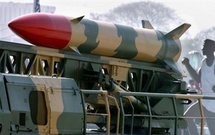 On 05 November 2013, Pakistan’s Strategic Forces Command once again tested the 60-km range Hatf-9 (Nasr) short-range ballistic missile (SRBM). Salvoes of four missiles were fired from multi-tube launchers. According to the ISPR, the nuclear-tipped Nasr missile has in-flight manoeuvre capability. The missile was first tested in April 2011 and then again in May 2012 and in February 2013. It is reported to be a replica of the Chinese M-20 missile.
On 05 November 2013, Pakistan’s Strategic Forces Command once again tested the 60-km range Hatf-9 (Nasr) short-range ballistic missile (SRBM). Salvoes of four missiles were fired from multi-tube launchers. According to the ISPR, the nuclear-tipped Nasr missile has in-flight manoeuvre capability. The missile was first tested in April 2011 and then again in May 2012 and in February 2013. It is reported to be a replica of the Chinese M-20 missile.
Dr Shireen Mazari, Chief Executive Officer, Strategic Technology Resources, has said that the Nasr missile is a technology demonstrator and has not yet been inducted into the nuclear arsenal. "We are signalling our acquisition of tactical missile capability and miniaturisation technology. This will allow our already developed cruise missiles - the Hatf-VIII (Ra'ad), which is an air-launched cruise missile (ALCM) and Hatf-VII (Babur), which is a ground-launched cruise missile (GLCM) - to be miniaturised for sea-launched submarine capability in order to move on to a second-strike capability."
Tactical nuclear weapons (TNWs) like the Nasr are inherently destabilising and there are several compelling reasons for leaving these out of the nuclear arsenal. Firstly, these are extremely complex weapons (particularly sub-kiloton mini-nukes, because of the precision required in engineering) and are difficult and expensive to manufacture and support technically. Inducting them into service even in small numbers would considerably raise the budget of the strategic forces.
Secondly, the command and control of TNWs needs to be decentralised at some point during war to enable their timely employment. Extremely tight control would make their possession redundant and degrade their deterrence value. Decentralised control would run the risk of their premature and even unauthorised use – Kissinger’s ‘mad major syndrome’. Thirdly, since the launchers must move frequently to avoid being targeted, dispersed storage and frequent transportation of TNWs under field conditions increases the risk of accidents. Lastly, the employment of conventional artillery and air-to-ground precision weapons by the enemy may damage or destroy stored nuclear warheads.
It was for many good reasons that the US and its NATO allies and the Soviet Union and Warsaw Pact forces developed, produced, stockpiled in large numbers and planned to use tactical nuclear weapons as weapons of war. Even the mini-nukes and the so-called ‘clean’ enhanced radiation neutron bombs would have, if used in substantial numbers in a European war, afflicted a few hundred million civilians, including future generations, with long-term radiation sickness of incalculable magnitude.
The professed military utility of blunting a major armoured offensive is debatable as the attacker would ensure that he does not present a concentrated target before the bulk of tactical nuclear weapons, or at least their delivery systems, have been destroyed in an initial phase that itself would turn out to be apocalyptic. Even then, the attacker would concentrate rapidly for short durations only at the point of decision and then disperse quickly. In the well-developed, semi-urban terrain of Punjab on both the sides of the Indo-Pak boundary, collateral damage would be unavoidable. Hundreds of thousands of civilian casualties would be politically unacceptable and unmanageable for an army fighting a war.
Political and diplomatic reasons also militate against the use of tactical nuclear weapons. A nuclear posture with a first use option – NATO’s in Europe and Pakistan’s current nuclear policy – is both repugnant and dangerous. It is also destabilising and naturally escalatory in nature. With the ongoing mega media revolution, public opinion is bound to undermine the credibility of the use of tactical nuclear weapons, and as deterrence is more than anything else a mind game, the lack of credibility does nothing for enhancing deterrence. Rather it creates new dangers.
The command and control of tactical nuclear weapons has naturally to be decentralised during war to enable their timely employment. Extremely tight control would make their possession redundant and degrade their deterrence value by several orders of magnitude. Decentralised control would run the risk of their premature and even unauthorised use based on the discretion of field commanders, however discerning and conscientious they may be.
Dispersed storage and frequent transportation under field conditions, since the launchers must move from hide to hide to avoid being easily targeted by the enemy, increases the risk of accidents as well as complicate nuclear security. The employment of conventional artillery and air-to-ground precision weapons by the enemy may damage or destroy forward stored nuclear warheads and, though the probability is low, may even set off a nuclear explosion. Also, widely dispersed nuclear warheads are difficult to guard effectively and may fall into Jihadi hands – a fear that cannot be taken lightly in the epicentre of Islamist fundamentalist terrorism.
Even though Pakistan has chosen to acquire these dangerous weapons, India has wisely opted not to go down the TNW route.The Nasr missile is said to be Pakistan’s answer to India’s Cold Start doctrine.The Pakistan army proposes to use the Nasr missile to drop a low-yield nuclear warhead on Indian mechanised forces that have entered Pakistani territory with a view to stopping the Indian offensive in its tracks. It is a patently flawed approach as, in response to a nuclear attack on its forces, India will execute its nuclear doctrine of massive retaliation and Pakistan will cease toexist as a functional nation state. Surely, that is not the end state that the Pakistan army is prepared to accept.
Courtesy : Institute of Peace and Conflict Studies (http://www.ipcs.org)